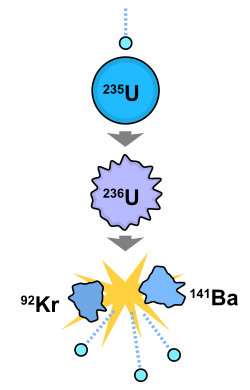Nuclear fission facts for kids
Nuclear fission is a nuclear process. It is when an atom splits apart into smaller atoms. The process gives off a lot of energy, and is used in nuclear weapons and nuclear reactors. Nuclear fission was discovered in December 1938 by the German nuclear chemist Otto Hahn and his assistant Fritz Strassmann in Berlin.
An atom is the smallest particle which makes up a chemical element (e.g. hydrogen, oxygen, magnesium). All atoms are very small. A small ball called a nucleus is at the center of every atom. Elements which have large nuclei, such as uranium and plutonium, can be made to fission.
If a (relatively) very large nucleus is hit by a slow-moving neutron, it will sometimes become unstable and break into two nuclei. When the nucleus breaks apart (or fissions) it releases a lot of energy and it also causes some neutrons to be released.
For a few isotopes one such fission can release many neutrons. If those neutrons then hit other atoms, they will make the other atoms split. This can happen again and again. This is called a nuclear chain-reaction, and it can release huge amounts of energy very quickly. The amount of energy released by a nuclear chain reaction is measured in kilotons. One kiloton is the same as the energy of one thousand tons of TNT (trinitrotoluene).
In a nuclear bomb, this must happen very quickly to make a very big explosion. In a nuclear reactor this must happen slowly to make heat. The heat is used to boil water into steam, which turns a turbine to generate electricity.
Images for kids
-
A visual representation of an induced nuclear fission event where a slow-moving neutron is absorbed by the nucleus of a uranium-235 atom, which fissions into two fast-moving lighter elements (fission products) and additional neutrons. Most of the energy released is in the form of the kinetic velocities of the fission products and the neutrons.
-
The stages of binary fission in a liquid drop model. Energy input deforms the nucleus into a fat "cigar" shape, then a "peanut" shape, followed by binary fission as the two lobes exceed the short-range nuclear force attraction distance, then are pushed apart and away by their electrical charge. In the liquid drop model, the two fission fragments are predicted to be the same size. The nuclear shell model allows for them to differ in size, as usually experimentally observed.
-
The cooling towers of the Philippsburg Nuclear Power Plant, in Germany.
-
Experimental apparatus similar to that with which Otto Hahn and Fritz Strassmann discovered nuclear fission in 1938. The apparatus would not have been on the same table or in the same room.
-
Drawing of the first artificial reactor, Chicago Pile-1.
See also
 In Spanish: Fisión nuclear para niños
In Spanish: Fisión nuclear para niños








